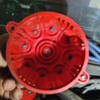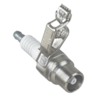Yesterday, on the way to a show, I was getting off the freeway and the car died coming off the offramp... started right back up and it was fine for the next mile or so to get to the show. Then on the way home, about to go on the freeway, it died... then started back up, but then died again on the freeway. Thankfully, was able to pull over to the side. I tried starting and it just felt exactly like I was out of gas even though my gauge said 3/4 full. I figured my gauge was bad so got some gas in it, and then it started up again... and then died about 500 feet later. Was able to make it home (literally coasting into my driveway) after about ten stops and starts. And at one point, had to let it sit for about 10 min before it would start. Voltage is fine, cranks fine, just won't start.
Any advice? I went under the car and checked the fuel pump (mechanical) and it didn't seem like it was leaking (per advice from somebody smarter than me). Warning, although I've done brakes, suspension, etc.. I am not as well-versed in engine/fuel mechanicals as most of you, so I apologize ahead of time for stupid questions/replies. Thanks.
P.S. I just had a lot of work done that included new dual fans, aluminum radiator, a bunch of electrical work in the console/gauges. I have no idea if that has anything to do with what's happening... but my headlight motor also died after all that work. Maybe a coincidence, but just to put it out there.




